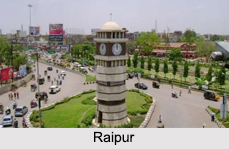 Cites of Chhattisgarh are playing a vital role in generating economy from the iron and steel industries and tribal cultural tourism. This central Indian state has urbanization in the midst of the wildlife sanctuaries and the forestry. These cities are connected with other cities of South India and cities of east India.
Cites of Chhattisgarh are playing a vital role in generating economy from the iron and steel industries and tribal cultural tourism. This central Indian state has urbanization in the midst of the wildlife sanctuaries and the forestry. These cities are connected with other cities of South India and cities of east India.
Raipur Raipur District
Raipur is a modernized capital city of industrial hubs in central India. This city is notified for the agriculture processed industries, iron and steel and cement industries. Kanha Tiger Reserve, Amarkantak, Bhoramdeo Temple, Dongargarh, Achanakmar Wildlife Sanctuary, Chitrakoot waterfalls, Indravati National Park, Kanger Valley National Park and Murrum Silli Dam are popular attractions that enhances the tourism of Chhatisgarh.
Bilaspur, Bilaspur District
Bilaspur is cleanest city in India and this metropolitan city is popular for the production of aromatic rice and Kosa silk sarees.
Durg, Durg District
Durg is developed near Seonath River and the people here cultivate Sufi philosophy.
Bhilai, Durg District
 Bhilai is an industrial city, dotted with several mines, iron ore, dolomite, coal and manganese industries. It was an early settlement area of Bhil tribe.
Bhilai is an industrial city, dotted with several mines, iron ore, dolomite, coal and manganese industries. It was an early settlement area of Bhil tribe.
Jagdalpur, Bastar District
Jagdalpur was the former capital city of Princely state of Bastar during the rule of British Empire in India. This city enjoys many religious festivals like Pongal, Ratha Yatra, Ganesh Chaturthi and Durga Puja.
Rajnandgaon, Rajnandgaon District
Rajnandgaon was once the most flourished city under Maratha rule in medieval India. International Hockey Stadium was established here in order to promote hockey.
Dhamtari, Dhamtari District
Dhamtari is known for the tribal people. Sitanadi Wildlife Sanctuary is the cynosure of this place.
Raigarh, Raigarh District
Raigarh is best known for the coal reserves and this place has the hydropower generation industry. Kelo River is the lifeline of Raigarh.
Ambikapur, Surguja District
Ambikapur was the capital city of Princely State of Surguja and from here Mahamaya Mandir, Tiger Point Waterfall, Chendra waterfall, Ramgarh, Kudargarh, Bhaiyathan and Tattapani.
Korba, Korba District
Korba is popular for the production of coal. Here Putka Hill is the popular tourism destination. Gevra is the nearest railway station to reach here.
Janjgir, Janjgir-Champa District
Janjgir is home of many thermal power plants and it is connected with National Highway 200.
Champa, Janjgir-Champa district
Champa is a city developed near Hasdeo River. Champa is popular for Indian Silk Sarees, gold and brasswares.
Kanker, Kanker District
Kanker is a developed city connected with National Highway No. 30. Kanker is dotted with villages and the Doodh River.
Mahasamund, Mahasamund District
Mahasamund is the gateway to enter Sirpur village and the mound, Sirpur Laxman Temple, Gandheswar Temple, Kodar Dam, Rajim Kumbh, Rajiv Lochan Temples and Khallari Temple. Sirpur Dance and Music Festival is a cynosure of this place.



















